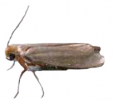
Problems with Casemaking Clothing Moths are controllable under professional care. Our treatment goal is to stop a problem at its source so it doesn’t keep coming back. Using state-of-the art equipment and methods, our licensed exterminators will inspect your home’s environment and construction to identify the problem and determine the best course of action.
The Case Making Clothing Moth is normally a pest of woolens, rugs, feathers, felts, skins, spices, drugs, furs, taxidermy mounts, and stored tobacco. It prefers to feed on animal products, but may feed on plant materials when necessary. The caterpillars of this Moth will construct a blanket or sack to occupy and carry with them at all times.
It is the same color as the item being eaten and it’s made of silk, fecal matter, and pieces of the food source. This sac enlarges as the larva grows and it will die if it is removed. It typically produces about 2 generations a year but depending on temperatures and food sources, the life cycle may be completed within 2 months or may take several years.
The larvae are small caterpillars (3/8-inch long) and have dark head capsules. Meanwhile, the adult moths are approximately 3/8 to ½ inch from wing tip to wing tip. The wings and body are light to golden brown and the front wings have three dark spots, but these distinguishing features are often rubbed off.
The adult females live about 30 days and will lay 100 to 300 eggs which hatch into tiny caterpillars within 4 to 10 days. Larvae develop through several stages and they reach to almost ½ inch long. Upon maturity, the adult moths will not feed and will seek merely seek to procreate. If you see this type of moth flying about, they are most likely males because the egg-laden females rarely fly and usually prefer to walk or run.
The best way to avoid problems with clothes moths is through prevention. Moths are much less attracted to clothes that have been dry cleaned prior to storage. Woolens and other susceptible fabrics should be dry cleaned or laundered before being stored for long periods. Cleaning kills any eggs or larvae that may be present and also removes perspiration odors that attract the pests.
Tight fitting containers are most useful to prevent or limit infestations of these pests. Moths can also be controlled by heating or freezing. And like most insects, moths are sensitive to extreme temperatures, for example, 110 degrees F to 120 degrees F are generally lethal to all insects if maintained for 30 minutes or more.
In addition, freezer temperatures of less than 0 degrees is also fatal, providing 72 hours have elapse and the temperatures was lowered quickly without giving the insects time to acclimate to the cold (slow cooling makes some insects immune to freezing) . Cool temperatures also slows development. It should also be noted that low relative humidity levels of 20% to 30% will also make the environment inhospitable to moths, since they are sensitive to drying conditions.
There are several common chemicals that will help with long term garment storage, they include paradiclorobenzene and naphthalene. These chemicals are sold in a crystalline form and have commonly been know as moth balls or crystals. Paradichlorobenzene turns into a heavier than air gas at about 50 degrees and kills all stages of moths at high concentrations. This high concentration may need to be maintained for 2 to 3 weeks.
However, please note that at high concentrations both of these chemicals are also very toxic to humans. Paradichlorobenzene may be a carcinogen and may also damage the liver and kidneys at high doses. And naphthalene can damage the liver and cause eye injury. Mothballs can be especially dangerous if accidentally eaten. In summary, mothball should only be used sparingly.
A safer approach to controlling moths is cleaning and use of a plant derived, lavandin oil dispensing hanger for clothes moth designed to hang between clothes in closets.
Bear in mind the following precautions, paradichlorobenzene will react with and melt or soften some hard plastics, such as polystyrene and Styrofoam (Polyethylene storage bags are not affected by PDB vapors.) A further precaution is not to use PDB for fumigating clothing that has plastic buttons or ornamentation.
Also, do not allow mothballs to come in direct contact with the clothing fabric; separate with paper or other barriers. Naphthalene is best used by scattering the balls or flakes in layers throughout the fabric or wool that is being treated. It does not react with plastic as does PDB.
However, please bear in mind that in moist conditions, naphthalene may produce a reddish-brown discoloration due to breakdown by bacteria. It may also corrode some metals and it should be placed within paper or applied in a similar fashion so that it does not directly contact the wool or fabric.